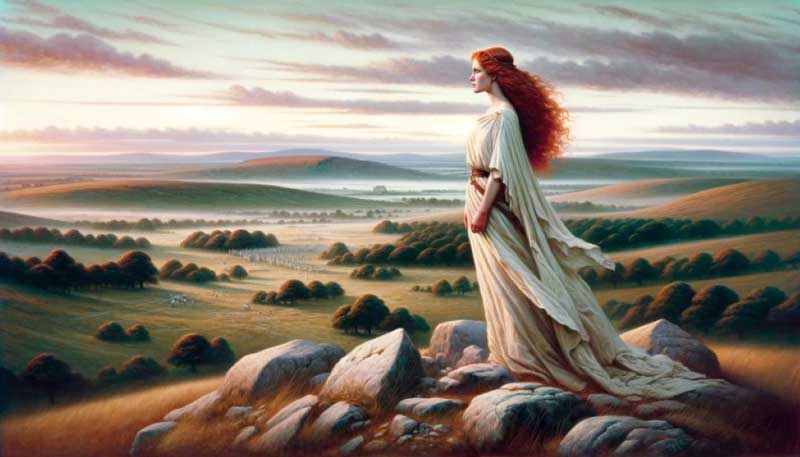
Boudica or Boudicca or Boudicea, the legendary warrior queen of the ancient Iceni or Eceni tribe of eastern Britain during the early Roman era, is considered a British national heroine and an iconic symbol of courage, commitment and leadership. She led a revolt against the Romans in AD 60 or 61, destroyed several Roman Settlements and almost drove Rome's imperial occupation forces off the island. However, despite her famous success in defeating the Romans in three great battles, the Romans reassembled, fought back, and finally crumbled her at the Battle of Watling Street. Nevertheless, she is remembered in history as the courageous warrior queen who fought against the mighty Romans, and is considered a symbol of resistance against oppression, struggle for justice, as well as women’s power.

It is interesting to note that Boudica, the name of the famous ancient warrior queen, is derived from the ancient British word bouda, which means victory. But unfortunately, although she has been painted and sculpted by several artists, films were made based on her life and numerous books, both of an academic and fictional nature, were written about her, many aspects of her life remain shrouded in mystery, which is a topic of intense debate among the historians and archaeologists for the lack of proper documentation.
The archaeological discoveries, such as the Snettisham Treasure found in the English county of Norfolk between 1948 and 1973, and the ruined layers found at the sites of Camulodunum (Colchester) Londinium (London), and Verulamium (St. Albans), destroyed by Boudica’s army, have helped to corroborate the accounts of her valour. But for the accounts of her alleged battles against the Romans, scholars have to depend only on the accounts of three ancient Roman historians, Tacitus, Suetonius and Cassius Dio, none of whom was a contemporary of the legendary warrior queen.

The Boudican revolt, the armed uprising by the native Celtic Britons, under the leadership of Boudica, against the Roman Empire during the Roman conquest of Britain, was mentioned by Tacitus in his works titled The Agricola (AD 98) and The Annals (AD 110s), as well as by Suetonius, in his De vita Caesarum (AD 121), long after the incident. Additionally, both Tacitus and Dio give an account of the fiery battle-speeches delivered by Boudica to incite her people, though those were later considered imaginary by the scholars, and thought to be intentionally designed to create an image of patriotism that turned Boudica into a legendary figure. Although, the detailed description of the revolt is included in Cassius Dio’ s work on the history of Rome and its empire, Cassius Dio began his work long after, around 140 years, after the death of Boudica.

Little is known about Boudicca's upbringing, but it is believed by many that she was born into an elite family in the ancient town of Camulodunum (present Colchester) in around 30 AD, and as an adolescent, she was sent away to another aristocratic family to be trained in the history and customs of the tribe, as well as to be trained to fight with swords and other weapons, like other Celtic women who were distinct in the ancient world for their liberty and rights, unlike their counterparts in Greek, Roman, and other ancient societies. However, before she reached adulthood, the Romans, led by Emperor Claudius, invaded Britain in 43 AD, when most of the Celtic tribes were forced to submit.
Nevertheless, following their normal practice, the Romans allowed the kingdoms to retain their independence for the lifetime of their current kings, in exchange of collecting hefty compensation. Prasutagus was one of those kings, with whom Boudicca was married at the age of 18, and had two daughters with him, named Isolda and Siora.

But the trouble began in AD 60/61, when Prasutagus died having bequeathed his kingdom to his two daughters and the Roman Emperor Nero. The Romans ignored the arrangement, and the kingdom was absorbed into the province of Roman Britannia. After that, as described by Tacitus, the Romans looted the king’s palace, ravaged his kingdom, enslaved his relatives and stripped all the Iceni chiefs of their ancestral lands. As if that was not enough, they flogged Boudica and gang-raped the young princesses, although it was not mentioned in the account of Cassius Dio. However, it was too much of a disgrace and humiliation on the part of the Iceni, because Boudica was not just a queen, she was also a respected priestess and possibly the embodiment of their goddess Andraste, an important figure in Celtic mythology, revered as the goddess of victory, war, and sovereignty.
The assault of the queen was more than a violation of their earthly leader, it was a cultural shock, as the rapes and floggings desecrated the Iceni’s entire cultural sentiment and system of beliefs. As a result, when Boudica began her campaign to assemble the Britons to fight against the Romans, she gained the support of another aggrieved tribe known as the Trinovantes. Eventually, Boudicca’s personal charisma and firm conviction inspired thousands to join her, culminating in a massive army, ready to strike panic and fear into the heart of Rome.

According to Lucius Cassius Dio, also known as Dio Cassius, the Roman historian and senator, who authored 80 volumes of the history of ancient Rome, Boudica with her tall figure, fierce eyes, bone chilling harsh voice, a great mass of the reddish hair falling down to her hips, was a striking woman, presenting the image of a determined war leader. When she delivered her fiery battle-speeches to incite her army, she used to have a large golden necklace around her neck, wore a tunic of divers colour, covered under a thick mantle, fastened with a brooch and clutching a spear in her firm hand. Determined to take revenge, she amassed a huge army of 120,000 men, comprising the Iceni and the Trinovantes, and focused her wrath on the Roman settlements in the country. However, the sudden uprise caught the Romans unawares. During that time, the Roman forces were busy in the western fringes of Britannia, battling to suppress the political power of the Druids on Anglesey, and the only Roman troops available in the area, apart from the few within the colony, were the only 200 auxiliaries located in London, who were not properly equipped with arms to confront the huge combined army of Boudica.

Boudica took the advantage of the situation, stormed, captured and destroyed the Roman settlements of Camulodunum (Colchester) Londinium (London), and Verulamium (St. Albans), one by one, and mercilessly killed the Roman settlers, as they wanted to take revenge and were not interested to Roman population as prisoners. It was reported both by Cassius Dio and Tacitus that during that time, the rebels slaughtered around 80,000 people, even the Roman women were impaled on spikes and had their breasts hacked off and sewn to their mouths. However, Gaius Suetonius Paulinus, the Roman commander on the island, had other things in his mind. He tried and could amass a band of well trained and properly equipped men, numbering only around 10,000 to fight the rebels, and took the position in a narrow defile with a forest at the rear, somewhere near Watling Street. Although the Roman army was heavily outnumbered, they were technically more trained, as they tactically used the terrain to their advantage, launching javelins at the Britons before advancing in a wedge-shaped formation and finally, deployed cavalry to finish the game. Ultimately, the superior Roman tactics and discipline overcame the ferocity of the Celtic rebels, the rebel army, under the leadership of Boudica, was crushed at the Battle of Watling Street, and were slaughtered. According to Tacitus, neither the women nor even the animals were spared. While Boudica took poison to avoid being captured, her daughters disappeared from the record.

Despite her defeat in her last battle, Boudica has secured a special place in British folk history, remembered for her courage; dedication and strong determination to stand and fight against operation. In 1902 a bronze statue of the warrior queen, atop a war chariot and clutching a spear, designed by Thomas Thorneycroft, was unveiled next to Westminster Bridge in London.
